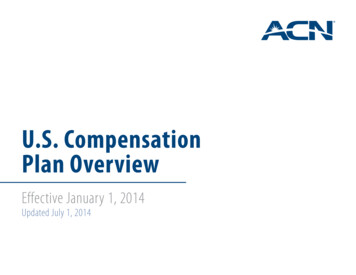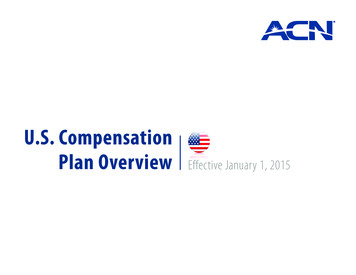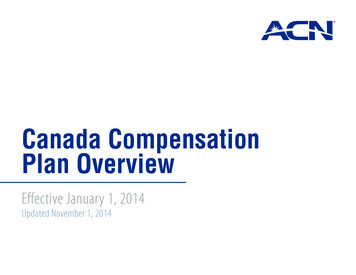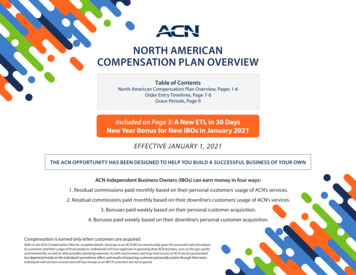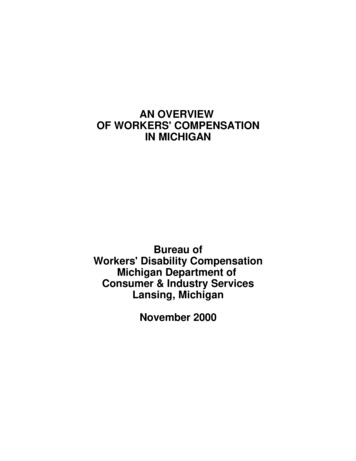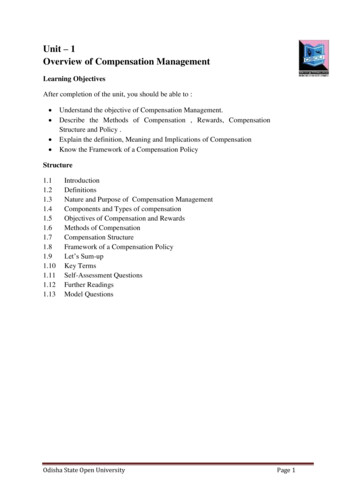
Transcription
Unit – 1Overview of Compensation ManagementLearning ObjectivesAfter completion of the unit, you should be able to : Understand the objective of Compensation Management.Describe the Methods of Compensation , Rewards, CompensationStructure and Policy .Explain the definition, Meaning and Implications of CompensationKnow the Framework of a Compensation 1.121.13IntroductionDefinitionsNature and Purpose of Compensation ManagementComponents and Types of compensationObjectives of Compensation and RewardsMethods of CompensationCompensation StructureFramework of a Compensation PolicyLet’s Sum-upKey TermsSelf-Assessment QuestionsFurther ReadingsModel QuestionsOdisha State Open UniversityPage 1
1.1IntroductionIf the abilities of employees have been developed to the point where they meetor exceed job requirements, it is now appropriate that they be equitablycompensated for their contributions. The factors affecting the determination ofequitable compensation are many, varied and complex. And management mustcome to some decision concerning the basic wage or salary. To motivateimproved performance on the job many systems of variable compensationhave been devised andfinally organizations have developed numerous ways of providingsupplementary compensation in the form of fringe benefits.An incentive or reward can be anything that attracts a workers attention andstimulates him to work. An incentive programme is most frequently built onmonetary rewards but may also include a variety of non-monetary rewards.The term reward has been used both in the restricted sense of participation andthe widest sense of financial motivation. The concept of reward implies theincreased wiliness or motivation to work and not the capacity to work.Compensation and Rewards determination may have one or more objectives,which may often be in conflict with each other. The objectives can beclassified under four broad headings.The first is equity, which may take several forms. They include incomedistribution through narrowing of inequalities, increasing the wages of thelowest paid employees, protecting real wages (purchasing power), the conceptof equal pay for work of equal value compensation management strives forinternal and external equity. Internal equity requires that, pay be related to therelative worth of a job so that similar jobs get similar pay. External equitymeans paying workers what comparable workers are paid by other firms in thelabor market. Even compensation differentials based on differences in skills orcontribution are all related to the concept of equity.Efficiency, which is often closely related to equity because the two conceptsare not antithetical. Efficiency objectives are reflected in attempts to link tolink a part of wages to productivity or profit, group or individual performance,acquisition and application of skills and so on. Arrangements to achieveefficiency may be seen also as being equitable (if they fairly rewardperformance) or inequitable (if the reward is viewed as unfair).Macro economic stability through high employment levels and low inflation,of instance, an inordinately high minimum wage would have an adverseimpact on levels of employment, though at what level this consequence wouldoccur is a matter of debate. Though compensation and compensation policiesare only one of the factors which impinge on macro-economic stability, theydo contribute to (or impede) balanced and sustainable economic development.Efficient allocation of labor in the labor market. This implies that employeeswould move to wherever they receive a net gain, such movement may be formone geographical location to another or form on job to another (within orOdisha State Open UniversityPage 2
outside an enterprise). The provision or availability of financial incentivescauses such movement.For example, workers may move form a labor surplus or low wage area to ahigh wage area. They may acquire new skills to benefit form the higher wagespaid for skills. When an employer’s wages are below market rates employeeturnover increases. When it is above market rates the employer attracts jobapplicants. When employees move from declining to growing industries, anefficient allocation of labor due to structural changes takes place.1.2 DefinitionsCompensation is a systematic approach to providing monetary value toemployees in exchange for work performed. Compensation may achieveseveral purposes assisting in recruitment, job performance, and jobsatisfaction.Compensation is a tool used by management for a variety of purposes tofurther the existence of the company. Compensation may be adjustedaccording the business needs, goals, and available resources.Compensation may be used to· Recruit and retain qualified employees.· Increase or maintain morale/satisfaction.· Reward and encourage peak performance.· Achieve internal and external equity.· Reduce turnover and encourage company loyalty.· Modify (through negotiations) practices of unions.Recruitment and retention of qualified employees is a common goal shared bymany employers. To some extent, the availability and cost of qualifiedapplicants for open positions is determined by market factors beyond thecontrol of the employer. While an employer may set compensation levels fornew hires and advertise those salary ranges, it does so in the context of otheremployers seeking to hire from the same applicant pool.Morale and job satisfaction are affected by compensation. Often there is abalance (equity) that must be reached between the monetary value theemployer is willing to pay and the sentiments of worth felt be the employee. Inan attempt to save money, employers may opt to freeze salaries or salary levelsat the expense of satisfaction and morale. Conversely, an employer wishing toreduce employee turnover may seek to increase salaries and salary levels.Compensation may also be used as a reward for exceptional job performance.Examples of such plans include: bonuses, commissions, stock, profit sharing,gain sharing.Employee compensation refers to all forms of pay or rewards going toemployees and arising from their employment, and it has two mainOdisha State Open UniversityPage 3
components. There are direct financial payments in the form of wages,salaries, incentives, commissions and bonuses and there are indirect paymentsin the form of financial benefits like employee paid insurance and vacations.So in nutshell we can say that employee compensation refers to all the formsof pay or rewards going to employees and arising from their employment.Compensation includes direct cash payments, indirect payments in the form ofemployee benefits & incentives to motivate employees to strive for higherlevels of productivity is a critical component of employment relationship.Compensation is affected by many factors like labour market factors,collective bargaining, government legislation & top management philosophyregarding pay benefits.1.3 Nature and Purpose of CompensationManagementProcess of compensation management is to establish & maintain an equitablewage & salary structure & an equitable cost structure .it involves jobevaluation, wage & salary survey, profit sharing &control of pay costs.Two important functions of compensation· Equity function· Motivation functionEquity is based on past & current performance & motivation with which thework has been performed in the past & current performance.Nature and Purpose of compensation managementThe basic purpose of compensation management is to establish and maintainan equitable reward system. The other aim is the establishment andmaintenance of an equitable compensation structure, i. e, an optimal balancingof conflicting personnel interests so that the satisfaction of employees andemployers is maximized and conflicts minimized. The compensationmanagement is concerned with the financial aspects of needs, motivation andrewards. Managers, therefore, analyze and interpret the needs of theiremployees so that reward can be individually designed to satisfy these needs.For it has been rightly said that people do what they do to satisfy some need.Before they do anything, they look for a reward or pay-off.The reward may be money or promotion, but more likely it will be some payoff-a smile, acceptance by a peer, receipt of information, a kind word ofrecognition etc.Odisha State Open UniversityPage 4
From individual standpoint -remuneration is a major source of an individual’spurchasing power. It determines his or her status, prestige & worth in society.From enterprise stand point- compensation is a crucial element in the cost ofproduction, which is expected to permit adequate profits leading to increase innew capital, expansion production,and capacity.From national point of view –dissatisfied work force hampers equitabledistribution of aggregate real income among various group involved .it causesinflation.A Sound Compensation Structure Tries to Achieve these Objectives-To attract manpower in a competitive market.To control wages &salaries & labour costs by determining rate change& frequency of increment.To maintain satisfaction of employees by exhibiting that remunerationis fair adequate & equitable.To induce & reward improved performance, money is an effectivemotivator.a. For employees1. Employees are paid according to requirements of their jobs, i.e., highlyskilled jobs are paid more compensation than low skilled jobs. This eliminatesinequalities.2. The chances of favoritism (which creep in when wage rates are assigned)are greatly minimized.3. Job sequences and lines of promotion are established wherever they areapplicable.4. Employees’ morale and motivation are increased because of the soundcompensation structure.b. To Employers1. They can systematically plan for and control the turnover in theorganization.2. A sound compensation structure reduces the likelihood of friction andgrievances over remuneration3. It enhances an employee’s morale and motivation because adequate andfairly administered incentives are basic to his wants and needs.4. It attracts qualified employees by ensuring and adequate payment for all thejobs.Now we come to the principles of Compensation· Differences in pay should be based on differences in job requirements.· Wage & salary level should be in line with those prevailing in the job market.· Follow the principle of equal pay for equal work.Odisha State Open UniversityPage 5
· Recognize individual differences in ability & contributions.· The employees & trade unions should be involved in while establishing wagerates.· The wages should be sufficient to ensure for the worker &his familyreasonable standard of living.· There should be a clearly established procedure for redressal of grievancesconcerning wages· The wage & salary structure should be flexible .· Wages due to employees should be paid correctly & promptly.· A wage committee should review & revise wages from time to time.1.4 Components and Types of compensationEmployees as fair if based on systematic components will perceivecompensation. Various compensation systems have developed to determine thevalue of positions. These systems utilize many similar components includingjob descriptions, salary ranges/structures, and written procedures.The components of a compensation system include:· Job Descriptions: A critical component of both compensation and selectionsystems, job descriptions define in writing the responsibilities, requirements,functions, duties, location, environment, conditions, and other aspects of jobs.Descriptions may be developed for jobs individually or for entire job families.· Job Analysis: The process of analyzing jobs from which job descriptions aredeveloped. Job analysis techniques include the use of interviews,questionnaires, and observation.· Job Evaluation: A system for comparing jobs for the purpose ofdetermining appropriate compensation levels for individual jobs or jobelements. There are four main techniques: Ranking, Classification, FactorComparison, and Point Method.· Pay Structures: Useful for standardizing compensation practices. Most paystructures include several grades with each grade containing a minimumsalary/wage and either step increments or grade range. Step increments arecommon with union positions where the pay for each job is pre-determinedthrough collective bargaining.· Salary Surveys: Collections of salary and market data. May include averagesalaries, inflation indicators, cost of living indicators, salary budget averages.Companies may purchase results of surveys conducted by survey vendors ormay conduct their own salary surveys. When purchasing the results of salarysurveys conducted by other vendors, note that surveys may be conductedwithin a specific industry or across industries as well as within onegeographical region or across different geographical regions. Know whichindustry or geographic location the salary results pertain to before comparingthe results to your company.Different Types of Compensation?Different types of compensation include:Odisha State Open UniversityPage 6
· Base Pay· Commissions· Overtime Pay· Bonuses, Profit Sharing, Merit Pay· Stock Options· Travel/Meal/Housing AllowanceBenefits including: dental, insurance, medical, vacation, leaves, retirement,taxes.In a layman’s language the word Compensation means something, such asmoney, given or received as payment or reparation, as for a service or loss. Onthe other hand, the wordReward means something given or received in recompense for worthybehavior or in retribution for evil acts.Now students let us try to demarcate between compensation and rewardsIn a layman’s language the word Compensation means something, such asmoney, given or received as payment or reparation, as for a service or loss.On the other hand, the word Reward means something given or received inrecompense for worthy behavior or in retribution for evil acts.The word Compensation may be defined as money received in theperformance of work, plus the many kinds of benefits and services thatorganizations provide their employees.On the other hand, the word Reward or Incentive means anything that attractsan employees’ attention and stimulates him to work. An incentive scheme is aplan or a programme to motivate individual or group performance.An incentive programme is most frequently built on monetary rewards(incentive pay or monetary bonus), but may also include a variety of nonmonetary rewards or prizes.Compensation or rewards (incentives) can be classified into1. Direct compensation and2. Indirect compensation.Money is included under direct compensation (popularly known as basicsalary or wage, i.e. gross pay) where the individual is entitled to for his job,overtime-work and holiday premium, bonuses based on performance, profitsharing and opportunities to purchase stock options.While benefits come under indirect compensation, and may consist of life,accident, and health insurance, the employer’s contribution to retirement(pensions), pay for vacation or illness, and employer’s required payments foremployee welfare as social security.Odisha State Open UniversityPage 7
While French says, the term “ Incentive system” has a limited meaning thatexcludes many kinds of inducements offered to people to perform work, or towork up to or beyond acceptable standards. It does not include:1. Wage and salary payments and merit pay;2. Over-time payments, pay for holiday work or differential according to shift,i.e. all payments which could be considered incentives to perform work atundesirable times; and3. Premium pay for performing danger tasks.It is related with wage payment plans which tie wages directly or indirectly tostandards of productivity or to the profitability of the organization or to bothcriteria. Compensation represents by far the most important and contentiouselement in the employment relationship, and is of equal interest to theemployer, employee and government.1. To the employer because it represents a significant part of his costs, isincreasingly important to his employee’s performance and tocompetitiveness, and affects his ability to recruit and retain a laborforce of quality.2. To the employee because it is fundamental to his standard of living andis a measure of the value of his services or performance.3. To the government because it affects aspects of macroeconomic stabilitysuch as employment, inflation, purchasing power and socio – economicdevelopment in general.While the basic wage or pay is the main component of compensation, fringebenefits and cash and non-cash benefits influence the level of wages or paybecause the employer is concerned more about labor costs than wage rates perse. The tendency now is towards an increasing mix of pay element ofexecutive compensation has substantially increased in recent years.Basic Purpose for Establishment of a Sound Compensation and RewardAdministrationThe basic purpose of establishment of a sound compensation and rewardadministration is to establish and maintain an equitable compensationstructure.Its secondary objective is the establishment and maintenance of an equitablelabor-cost structure, an optimal balancing of conflicting personnel interests sothat the satisfaction of employees and employers is maximized and conflictsminimized.A sound wage and salary administration tries to achieve these objectivesa. For employees1. Employees are paid according to requirements of their jobs, i.e., highlyskilled jobs are paid more compensation than low skilled jobs. This eliminatesinequalities.Odisha State Open UniversityPage 8
2. The chances of favoritism (which creep in when wage rates areassigned) are greatly minimized.3. Job sequences and lines of promotion are established wherever they areapplicable.4. Employees’ morale and motivation are increased because a wageprogramme can be explained and is based upon facts.b. To Employers1. They can systematically plan for and control their labor costs.2. In dealing with a trade union, they can explain the basis of their wageprogramme because it is based upon a systematic analysis of job andwage facts.3. A wage and salary administration reduces the likelihood of friction andgrievances over wage inequities.4. It enhances an employee’s morale and motivation because adequate andfairly administered wages are basic to his wants and needs.5. It attracts qualified employees by ensuring and adequate payment for allthe jobs.1.5 Objectives of Compensation and RewardsThe first is equity, which may take several forms. They include incomedistribution through narrowing of inequalities, increasing the wages of thelowest paid employees, protecting real wages (purchasing power), the conceptof equal pay for work of equal value compensation management strives forinternal and external equity. Internal equity requires that, pay be related to therelative worth of a job so that similar jobs get similar pay. External equitymeans paying workers what comparable workers are paid by other firms in thelabor market. Even compensation differentials based on differences in skills orcontribution are all related to the concept of equity.Efficiency, which is often closely related to equity because the two conceptsare not antithetical. Efficiency objectives are reflected in attempts to link tolink a part of wages to productivity or profit, group or individual performance,acquisition and application of skills and so on. Arrangements to achieveefficiency may be seen also as being equitable (if they fairly rewardperformance) or inequitable (if the reward is viewed as unfair).Macro economic stability through high employment levels and low inflation,of instance, an inordinately high minimum wage would have an adverseimpact on levels of employment, though at what level this consequence wouldoccur is a matter of debate. Though compensation and compensation policiesare only one of the factors which impinge on macro-economic stability, th
Process of compensation management is to establish & maintain an equitable wage & salary structure & an equitable cost structure .it involves job evaluation, wage & salary survey, profit sharing &control of pay costs. . From enterprise stand point- compensation is a crucial element i

